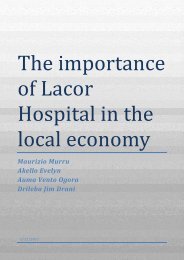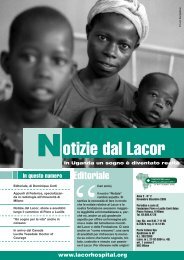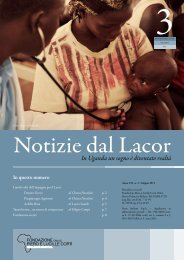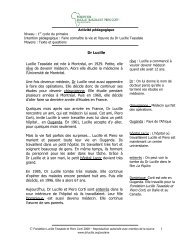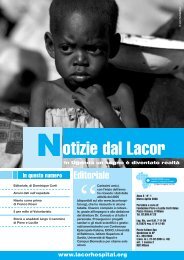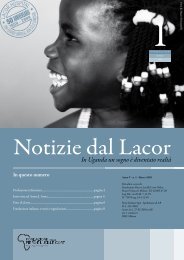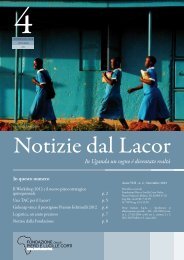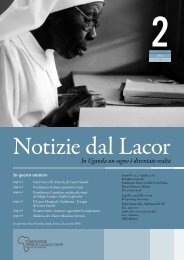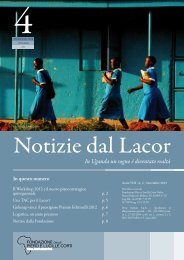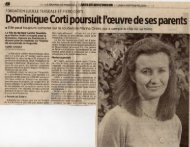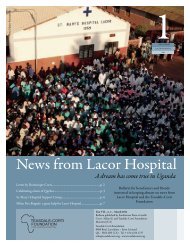News from Lacor Hospital - Fondazione Corti
News from Lacor Hospital - Fondazione Corti
News from Lacor Hospital - Fondazione Corti
Create successful ePaper yourself
Turn your PDF publications into a flip-book with our unique Google optimized e-Paper software.
ary. This was a big step forward, not only for us, but<br />
for all the seven missionary hospitals, and for some<br />
Ugandan government hospitals that, assisted and organized<br />
by the CUAMM projects, could finally develop<br />
and improve the quantity and quality of their work.<br />
At this point it is impossible for us to go further<br />
without mentioning at least a few of the many doctors<br />
who arrived at Gulu: Prof. Dalla Bernardina, Bolognesi,<br />
Busato, Rho, Stefanini, Molinari, Prof. Warley, Dr. Desjardins<br />
<strong>from</strong> Canada and Prof. Parson <strong>from</strong> the United<br />
States. All of them shared their great competences and<br />
qualities. Of course, these few words does them no justice;<br />
we are sorry and secretly ashamed because it is<br />
not fair to speak only about Piero and Lucille.<br />
In 1972, we opened the school for professional nurses<br />
with 90 students for the three year course, and<br />
three peripheral health centres in Opit, Amuru and<br />
Pabo within 45 km <strong>from</strong> Gulu. In 1981, we started the<br />
training of health educators and opened the school<br />
for laboratory technicians.<br />
ECONOMIC HELP<br />
At first we searched for “benefactors” exclusively<br />
among family, friends and “friends of relatives and of<br />
friends”. From ’68 to ’84, the major donors were Catholic<br />
non-government organizations (NGOs) such as Misereor<br />
(Germany), Peace and Development with Fame-Pereo, the<br />
Roncalli Foundation, Oxfam, Oeuvre du Cardinal Léger<br />
(Canada), Mani Tese (Italy).<br />
While the <strong>Hospital</strong> developed, the economic, political<br />
and social conditions in Uganda were undergoing dramatic<br />
changes. In 1971, with the arrival on the scene of<br />
Idi Amin, things began to fall apart even faster and<br />
reached an unimaginable decay, and continued <strong>from</strong> ’79<br />
until ’85 with the second Obote period.<br />
These long years of atrocities and devastations in<br />
every aspect of social life produced extreme poverty<br />
and many deaths caused by violence, lack of medical<br />
assistance, hunger and a lot of child malnutrition<br />
for the almost 2 million people in northern Uganda.<br />
Our <strong>Hospital</strong> too has lived through very dramatic periods.<br />
Many among the readers will ask themselves<br />
how <strong>Lacor</strong> could keep increasing both facilities and<br />
output, despite the harsh conditions in which it operated:<br />
economic decline, wars, dictatorships, rebellions,<br />
destructions, the fear that weighed on everyone,<br />
the difficulty in getting supplies, all should have<br />
pushed us to give up and leave. Why did we stay? It is<br />
true that difficulties are a challenge. At <strong>Lacor</strong> it is<br />
a duty to believe in Providence, to keep a firm hold on<br />
optimism and never give up!<br />
A solution for all of these difficulties was the Support<br />
Group in Italy, which has offered logistic and administrative<br />
support and even more, for years. It has<br />
raised funds, purchased and sent equipment, medicines,<br />
construction materials, food and almost anything the<br />
<strong>Hospital</strong> needed in order to function through three or<br />
four containers and air shipments to <strong>Lacor</strong> each year.<br />
3



